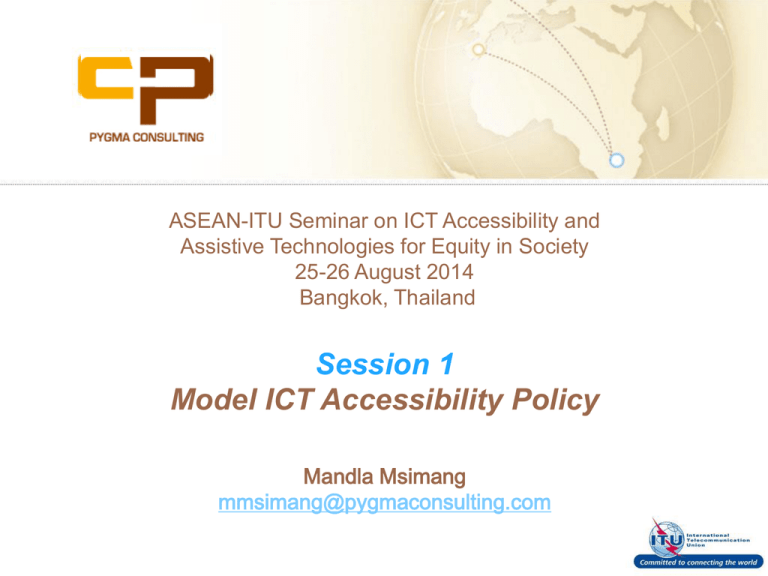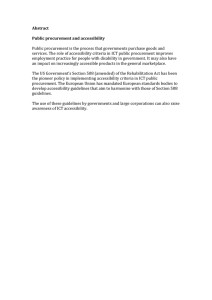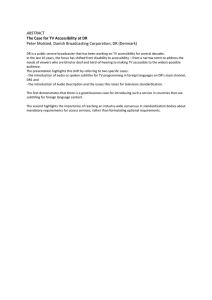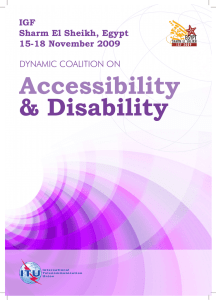ASEAN-ITU Seminar on ICT Accessibility and 25-26 August 2014
advertisement

ASEAN-ITU Seminar on ICT Accessibility and Assistive Technologies for Equity in Society 25-26 August 2014 Bangkok, Thailand Session 1 Model ICT Accessibility Policy Mandla Msimang mmsimang@pygmaconsulting.com Passion | Professionalism | Integrity Introduction o Model ICT Accessibility Policy Background and Objectives UN Convention on the Rights of Persons with Disabilities Overview Approach taken o Current Key Issues in ICT Accessibility o Overview of Modules ICT Legal, Policy and Regulatory Framework Public ICT Access Framework Accessibility Policy Framework Television Accessibility Policy Framework Web Accessibility Policy Framework Model Policy forromoting ICT Accessibility in Public Procurement Passion | Professionalism | Integrity Model ICT Accessibility Policy Background and Objectives o Model Accessibility Policy was developed pursuant to UN Convention on the Rights of Persons with Disabilities (successful achievement relies on adoption and early implementation of policies by countries) ITU and G3ict ICT Accessibility Policy Toolkit www.e-accessibilitytoolkit.org o A resource for ICT policy makers, regulators and other stakehodlers including NGOs, persons with disabilities and parliamentarians o Designed to assist in policy making in public access, mobile communications, TV/video programming, web accessibility and public procurement o Sets out principles for policy formulation and implementation through legilsation, regulations, standards and guidelines. o This tool will be published later this year Passion | Professionalism | Integrity Model ICT Accessibility Policy UN Convention on the Rights of Persons with Disabilities • Article 9 – defines ICT accessibility as an integral part of accessibility rights on par with transportation and the physical environment – requires all content, communication, hardware, software and interfaces to be accessible. • Article 30 – requires State Parties to “take all appropriate measures to ensure that Persons with Disabilities . . . enjoy access to television programmes [and] films . . . in accessible formats. • Article 2 – defines “communication” in an inclusive manner to include all possible means of communication- “languages, display of text, Braille, tactile communication, large print, accessible multimedia as well as written, audio, plain-language, human-reader and augmentative and alternative modes, means and formats of communication, including accessible information and communications technologies” …which can eliminate barriers for persons with disabilities in enjoying their fundamental freedoms and human rights (Article 3(f)). Passion | Professionalism | Integrity 4 Model ICT Accessibility Policy Transposing UNCRDP into ICT Policy and Law • States Parties have ICT policies, legislation and regulations • These key legal instruments must be updated to achieve the goal of promoting ICT accessibility • States Parties Disability laws also have to be updated to promote ICT accessibility • Updating States Parties Public Procurement laws may be one of the most effective ways to ensure the availability of accessible ICTs Passion | Professionalism | Integrity Model ICT Accessibility Policy Overview o Module 1 - Model ICT Legal, Policy and Regulatory Framework Module 2 - Model Public ICT Access Framework o Module 3 - Model Mobile Accessibility Policy Framework o Module 4 - Model Television Accessibility Policy Framework o Module 5 - Model Web Accessibility Policy o Module 6 - Model Policy for promoting ICT Accessibility in Public Procurement Passion | Professionalism | Integrity Model ICT Accessibility Policy Approach Taken o Each module is designed and drafted on the basis of a similar approach: Explains the goals sough to be achieved and an overview of steps to be taken Provides a generic approach and model text Includes annotations to • assist with the understanding of the basis for some proposed clauses (and to link back to the UNCRPD) • Identify areas where country-specific issues must be taken into account (e.g population, literacy, institutional framework) Includes appendices with supporting tools such as info for reader not familiar with ICT Accessibility policy, guidleines, checklists, etc Passion | Professionalism | Integrity Current Key Issues in Promoting ICT Accessibility Key Issues (1) o Mainstreaming ICT Accessibility through inclusive language, definitions, and provisions in policies, laws & regulations; o Identifying key steps to promote ICT Accessibility, such as making accessible devices available, in the case of public and mobile phones and TV sets. o Awareness raising among key stakeholders – creating awareness about the need to promote ICT Accessibility o Consensus building and inclusive policy-making through encouraging national debate and discourse Passion | Professionalism | Integrity Current Key Issues in Promoting ICT Accessibility Key Issues (2) o Promoting the setting of clear targets, and periodic monitoring and evaluation o Encouraging training, capacity building and educational programs on disability awareness o Promoting localization, for example of voice recognition and text-to speech interfaces – to ensure local relevance and uptake Passion | Professionalism | Integrity Overview of Modules Legal, Policy, Regulatory – Content o o o o o o o o Review of definitions in existing ICT/electronic comms law Options for regulation Public consultation Universal access and service (“UAS”) framework Consumer protection Emergency services Reporting requirements Changes to disability legislation/ disability rights law Passion | Professionalism | Integrity Overview of Modules Legal, Policy, Regulatory - Context o Options for Regulation – • License Conditions/ Authorisations • Regulations • Voluntary Measures – self/co -regulation o Definitions – • • • • Include “persons with disabilities” definition Include “ICT users” which includes PWD Add “underserved communities” which include PWD Expand “universal access” and “universal service” definitions to also include ICT accessibility for persons with disabilities Passion | Professionalism | Integrity Overview of Modules Mobile Phone Accessibility Availability provide customers a range of accessible products, services and devices meeting the requirements of various types of disabilities Affordability offer special and/or discounted rates and plans for users with disabilities – i.e. text only plans for the deaf Awareness Practical Tools: Model Mobile Accessibility Policy Model Code of Conduct (for mobile industry) Model Regulations (for regulators) train staff on accessible products and services Passion | Professionalism | Integrity Overview of Modules TV / Video Programming (1) o Broadcasters to deliver closed captioning/ subtitling o Content creators are responsible for creating the content for these services and delivering the content along with the programming to the broadcaster or AV content provider o Sets targets for number of broadcasts to be made accessible in next three years o Calls for awareness raising to users are aware that accessible broadcasting services exist Passion | Professionalism | Integrity Overview of Modules TV / Video Programming (2) o Audio Description to be provided in an official language of the country The language of the AD should be the same as the program audio o Subtitling countries can use audio subtitles o Signing requirements to be developed through open consultation o Electronic Programming Guide (EPG) – e.g. symbols to denote accessibility - subtitling (S), signing (SL) and audio description (AD). o Consider migration of requirements from analogue to digital environment Passion | Professionalism | Integrity Overview of Modules TV / Video Programming (3) o Licensed content providers required to develop a Code of Conduct on minimum standards for amount of programming with: Subtitling Visual signing Audio descriptions and audio subtitling Ability to adjust caption fonts, contrast and colors o Code to set 3, 5 and 10 year targets Passion | Professionalism | Integrity Overview of Modules Public Access - Requirement Checklist o PHYSICAL ENVIRONMENTS AND AWARENESS Is it easy for public access facility visitors to know what assistive hardware and software (1) as a licence condition is available in the public access facility? (regulated) Are parking areas, pathways, entrances to (2) Via public/ USAF funding, the building wheelchair-accessible and e.g. telecntres (funded) clearly marked? Are there high-contrast, large-print signs to (3) By SMEs and & throughout the public access facility? entrepreneurs, e.g. internet Is at least part of a service counter or desk cafes (unregulated) at a height accessible from a seated position/ accessible to persons in wheelchairs? Module recognises that public access is provided: Passion | Professionalism | Integrity Overview of Modules Public Access - Requirement Checklist STRATEGY, PLANNING, POLICIES, AND EVALUATION • Are people with disabilities included in planning and evaluating public access facility products and services? • • • • • PUBLIC ACCESS FACILITY STAFF TRAINING Are staff members familiar with the availability and use of accessible ICT features, assistive technology and alternate document formats? Have staff members received sensitivity training and training on use of ICTs by persons with disabilities? • • HARDWARE Is at least one large monitor available so that a larger amount of screen can be viewed while magnified? Is equipment marked with large-print and/or Braille labels? Do you provide alternate hardware to replace the standard mouse and/or keyboard (e.g., a trackball, joystick, mini-keyboard, one-handed keyboard)? SOFTWARE Do you provide special software that is beneficial to persons with disabilities (e.g., screen readers) Do electronic resources, including web pages, adhere to accessibility guidelines or standards? (Refer to Web Accessibility Module) Passion | Professionalism | Integrity 1 7 Overview of Modules Web Accessibility – Content o Defines how to make web content more accessible to persons with a wide range of disabilities, and to older persons with changing abilities due to ageing o Based on Web Content Accessibility Guidelines (WCAG 2.0)(ISO/IEC 40500:2012) o Focus is on public sector websites o Suggestion that industry professional associations issue voluntary codes of conduct reflecting conformance objectives and timelines similar to those for public sector sites Passion | Professionalism | Integrity Overview of Modules Web Accessibility Objectives X X Make it easier for users to see and hear content including separating foreground from background. X X Learning X Language Provide captions and audio descriptions for videos and other alternatives for multimedia. Neurologi cal Cognitive X Speech Hearing X Physical X Sight Provide text alternatives for non-text content. Examples of Impairment or Disability addressed by the Four Principles and 12 Guidelines of WCAG 2.0 X X X X Perceivable X X X Operable Make all functionality available from a keyboard. X X Provide users enough time to read and use content. X X X Do not design content in a way that causes seizures. Help users navigate and find content. X X X X X X X X X X X X X X X X X X X Understandable Make web pages appear and operate in predictable ways. X Help users avoid and correct mistakes. X Maximize compatibility with current and future user tools, including assistive technologies. X Passion | Professionalism | Integrity X X X X X X X X X X X X Conclusion o Successful achievement of UNCRPD relies on adoption and early implementation of policies by countries o Model ICT Policy is designed to assist in policy making in public access, mobile communications, TV/video programming, web accessibility and public procurement o Each module is quite detailed and tries to set out key princples and provide tools for regulators, policy makers, and other stakeholders o Important to use appropriate legal, regulatory and policy tools to implement ICT Accessibility commitments and intentions Passion | Professionalism | Integrity www.e-accessibilitytoolkit.org Passion | Professionalism | Integrity 21 Making TV Accessible Report •Prepared by Peter Looms, Chairman of ITU-T Focus Group on Audiovisual Media Accessibility •Looks at how TV can be made more accessible •Timely given the transition from analogue to digital TV http://www.itu.int/ITU-D/sis/PwDs/index.phtml Passion | Professionalism | Integrity 22 Making Mobile Phones and Services Accessible Report •Prepared by a team of experts •Explains in concrete terms, what is meant accessible mobile phones •Developments in accessible mobile apps •Business opportunities and case studies •Policy guidelines http://www.itu.int/ITU-D/sis/PwDs/index.phtml Passion | Professionalism | Integrity 23 Passion | Professionalism | Integrity


